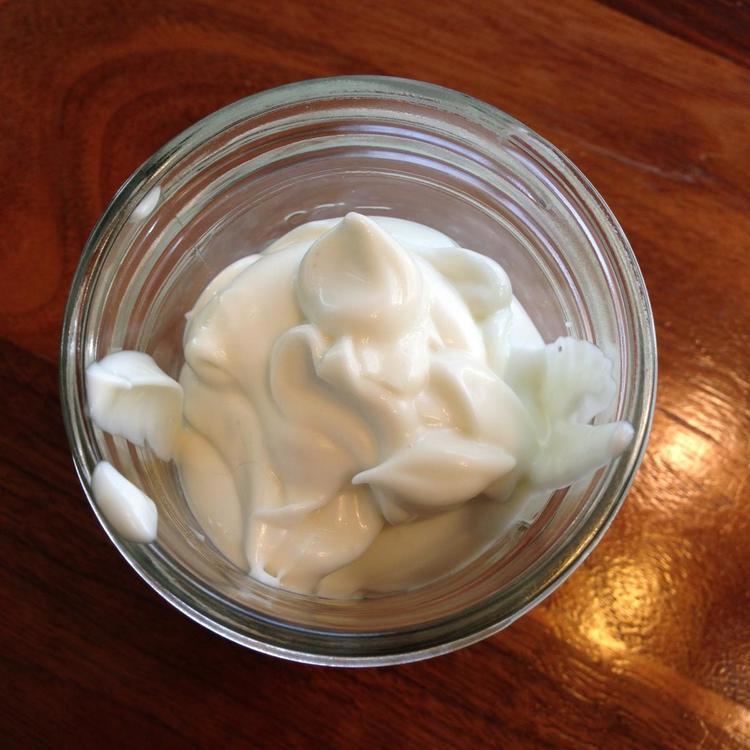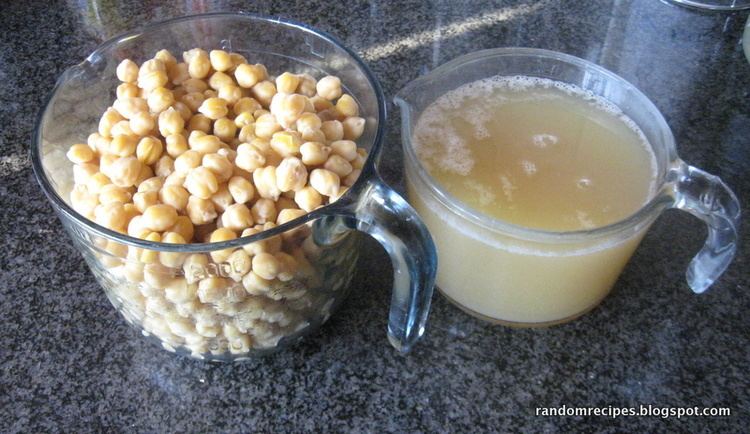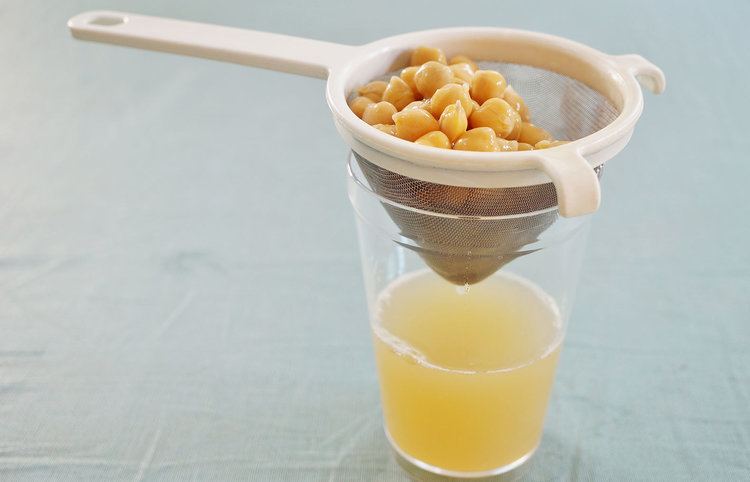 | ||
Similar Egg substitutes, Chickpea, Meringue, Potassium bitartrate, Nutritional yeast | ||
Make whipped cream from chickpeas only 2 ingredients aquafaba eggless recipes series
Aquafaba (/ˌɑːkwəfɑːbə/) is the name for the viscous water in which legume seeds such as chickpeas have been cooked.
Contents
- Make whipped cream from chickpeas only 2 ingredients aquafaba eggless recipes series
- Recipe aquafaba how to make the perfect vegan egg replacer
- Uses
- Origins
- Community
- Composition
- Novel uses
- Etymology
- References

Due to its ability to mimic functional properties of egg whites, aquafaba can be used as a direct replacement for egg whites in some recipes. Its composition makes it especially suitable for use by people with dietary, ethical, or religious reasons to avoid eggs.

Recipe aquafaba how to make the perfect vegan egg replacer
Uses

The most common use of aquafaba is as a replacement for egg white. It is composed of carbohydrates, proteins, and other soluble plant solids which have migrated from the seeds to the water during the cooking process. This unique combination of ingredients gives it a wide spectrum of emulsifying, foaming, binding, gelatinizing and thickening properties.

The general recommendation for use is to replace one medium egg white with 30 millilitres (2 tablespoons) of aquafaba in a recipe, or to replace one medium whole egg with 45 mL (3 tbsp)
The simplest way to use it is to decant the liquid from canned or boxed legumes such as white beans or chickpeas. Alternatively, it can be made by boiling, steaming, pressure cooking, or microwaving pulses in water until they are cooked.
Sweet applications where a direct substitution for egg whites has been found to be successful include meringues, macarons, nougat, icing, ice cream, fudge, and marshmallows.
Examples of other savory and other egg replacement applications include: baked goods, dairy substitutes, mayonnaise, cheese substitutes, batters, cocktails, and meat substitutes.
Aquafaba has about one tenth of the protein that egg whites have for a given weight. The difference in protein content may enable people who cannot properly metabolize proteins (e.g., PKU) a way to enjoy egg-based foods. However, the lower amount of protein also means that using it as a substitute for egg whites in food applications which rely heavily on egg protein for structure, such as angel food cakes, is not recommended.
The best aquafaba seems to be from chickpeas and white beans like great northern beans. Other legumes such as peas, soy beans, lentils, kidney, and black beans can also be used to some degree but have slightly different compositions than the chickpea and white bean aquafaba and may require more tinkering with the concentration to work well.
Origins
In December 2014, French chef, Joël Roessel, discovered that water from canned beans and other vegetables can be made to form foams much like protein isolates and flax mucilage. Roessel shared his experiments anonymously on a blog in France showing that the canning liquid can be used as a foaming agent. He also published recipes for floating island of Chaville, chocolate mousse, and he made a meringue made from chickpea liquid, sugar, corn starch and guar gum to demonstrate its foaming capabilities.
Around the same time, others in France began to experiment with using chickpea foam in desserts, which caught the attention of software engineer and vegan food enthusiast Goose Wohlt, in the United States. Wohlt discovered that the cooking liquid can be made and used in such a way as to completely replace egg white on its own without the need for stabilizers. He disclosed this to a popular vegan Facebook group in March 2015 by way of a recipe for an egg-free meringue using only two ingredients: chickpea cooking liquid and sugar.
A few days later, a new group was created on Facebook to encourage development, support even more discoveries, and popularize the new egg white substitute.
Community
There is an active international community of aquafaba users and developers centered around a main Facebook discussion group and an informational site.
The intention of the founders of the group was to explore the idea of developing aquafaba in a collaborative public manner, loosely borrowing ideas from the open source software world and applying them to the experimental food community. The hope was that by encouraging proper attribution outside the group and unrestricted contribution from members within the group, a natural nurturing atmosphere for trial and error where failures are deemed as important as successes and new discoveries would emerge, encouraging others to share openly. The premise was that new discoveries could be used openly in books, blogs, bakeries, and retail, while retaining some protection against larger forces in food manufacturing and industry restricting that development.
The community helps explore the full potential of the use of aquafaba as an egg replacer in recipes and also supports investigation into the underlying science. Crowd-sourced donations from members around the world made it possible to fund phytochemical testing on aquafaba samples. The analytical results of those tests have been released back to the public under a creative commons license.
Composition
Legume seeds, or pulses, are primarily composed of carbohydrates (starch, sugars, and fiber), proteins (albumins and globulins), and water. The carbohydrate component is significantly higher than the protein portion, and the starch portion of legumes is mostly amylose and amylopectin. A typical nutritional composition of chickpeas, for example, is listed as 19% protein, 61% carbohydrate, 6% lipids, and 14% water. However, these amounts are approximate and can vary by variety.
During the process of cooking legume seeds, the starches in the seed are gelatinized, setting up conditions which allow for soluble parts of the seed to disperse back out into the cooking water. The hotter the temperature, the higher the pressure, and the longer the seeds cook, the more material is transferred out of the seed into the solution.
Once the legumes are done cooking and filtered out, the water-soluble fraction that is left is aquafaba. Comparing the final composition of a cooked seed with a raw seed shows that under normal cooking conditions, approximately 5% of the initial dry weight has been transferred to the cooking water.
A further confirmation of the composition can be found in the nutritional testing of samples of chickpea aquafaba. In a sample submitted for analysis by the aquafaba community, we see approximately 5% soluble dry material in solution in the aquafaba. That ratio of soluble material is approximately the same ratio as found in the raw seed: 22% protein, 63% carbohydrates, 8.7% ash, and 4.3% lipids. An analysis of a sample of aquafaba using FT-IR spectroscopy also confirms that the final composition of aquafaba contains both starch, sugar, and protein fractions.
A concentration of 5% dry weight to water is typical for aquafaba, but the solution can also be reduced to increase the concentration to 10% or more, depending on the application. This can be especially useful for applications where emulsification and viscosity are more important than foaming capabilities. The concentration can also be tailored to produce a more stable foam using less aquafaba by carefully filtering non-soluble material from the solution and adjusting the concentration to the application.
In 2015, it was theorized that the most likely agent that caused the liquid to foam was saponins. However, further testing has shown that while chickpea saponin content exists in small quantities on the order of 1.21 mg/g, the saponin content of aquafaba is only on the order of .03 mg/g. This suggests that the foaming action may simply be a result of the starches and protein fractions.
Novel uses
Like egg whites, aquafaba has the ability to form stable foams when whipped which makes it suitable for desserts such as meringues. The foam formed by aquafaba is novel in that it can be for prolonged periods of time without collapsing (e.g., hours), whereas egg white foams can become dry and collapse.
Aquafaba can also be repeatedly frozen, thawed, heated, or cooled without substantially changing its properties as an egg replacer. The proteins are already denatured, and the starches are already gelatinized from the cooking process. In contrast, egg white irreversibly coagulates when its proteins are heated. The ability for aquafaba to be used at any temperature allows for novel applications such as hot foams, instant mixes, and recipes that take advantage of emulsification under heat.
Etymology
The word aquafaba was coined on March 13, 2015 by Goose Wohlt in order to provide the community with a common name for the cooking liquid. It is a concatenation of the Latin word for water, aqua, and the Latin word for bean, faba. It was also intended to suggest both a reference to the entire fabaceae legume family from which aquafaba is made as well as the notion that the discovery was also "faba"-lous. After significant international adoption, the word was officially submitted to the Oxford English Dictionary on its one-year anniversary.
